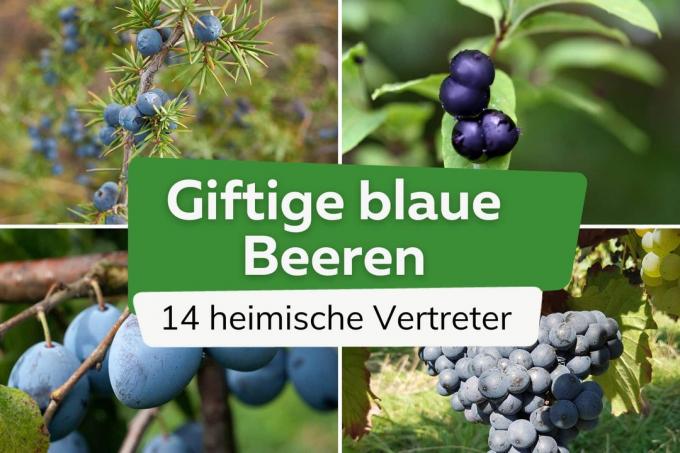
In the German-speaking countries there are numerous plants that are decorated with poisonous fruits. We introduce you to 14 poisonous blue berries from home.
In a nutshell
- Toxic to humans and/or animals
- often natural bird food
- no neophytes
Table of contents
- Poisonous blue berries from D to E
- Blue native berries with G
- K – T
- V – W
- frequently asked Questions
Poisonous blue berries from D to E
Fragrant claret (Polygonatum odoratum)
The fragrant white root is also known under the name Genuine Solomon's Seal. It belongs to the genus Polygonatum, which is native to the Eurasian part of the Holarctic. It is recognizable by the kinked, white flowers that ripen into frosted, blue-black berries. The slightly poisonous berries cause nausea, vomiting and diarrhea after consumption.
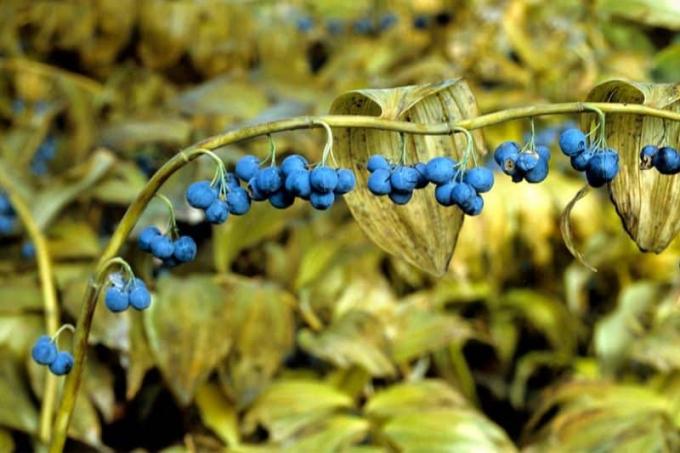
- Happen: Mixed forests (oaks and pines), herbaceous borders, under shrubs
- fruit ripening: August to September
- growth height: 15 to 100cm
- Growth: herbaceous, hanging
Einberry (Paris quadrifolia)
The herb is native to all of Europe and can be recognized by its characteristic growth with one flower per plant. The berries, which are poisonous to humans and dogs, are dark blue-black in color and are reminiscent of plump blueberries (Vaccinium myrtillus) in shape. Symptoms after consumption include nausea and dizziness, severe miosis and respiratory paralysis.
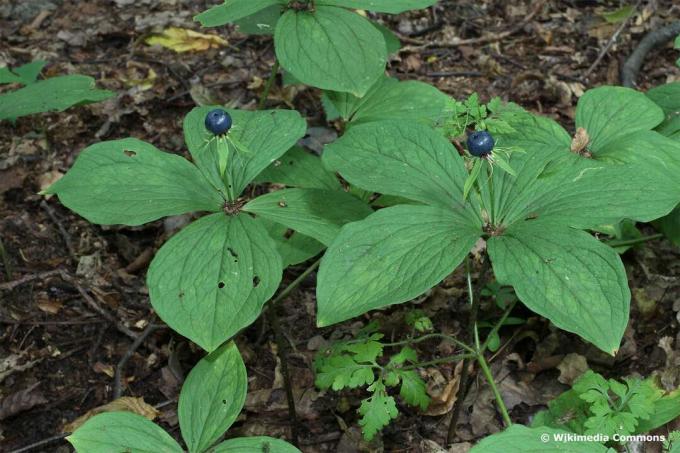
- Happen: Forest areas (oaks, beeches), alluvial forests, mixed coniferous forests
- fruit ripening: July to mid-September
- growth height: up to 30 cm
- Growth: herbaceous, upright
A notice: As with the herb, there are many poisonous plants whose berries are blue-black or black-blue. Because of this, you need to look carefully when you find the fruit in the wild.
Blue native berries with G
Common Ivy (Hedera helix)
One of the best-known poisonous plants in German-speaking countries the ivy, whose green to blue-black berries are toxic to humans, pets, and horses. The berries are close together and recognizable by their discus remnants. Symptoms follow after eating up to three fruits and range from diarrhea to convulsions and death from shock.
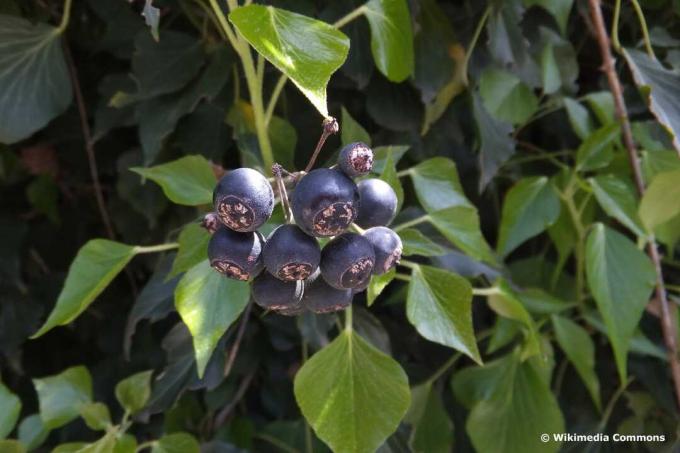
- Happen: Wooded areas, riparian forests, abandoned building structures, quarries
- fruit ripening: mid-January to April
- growth height: up to 30 m
- Growth: creeping, climbing, with tree species aged
A notice: Form despite the annual onset of fruit ripening ivy specimens first blossoms and thus fruits only appear from the age of about eight years. There are often no berries on ground-covering ivy.
Common juniper (Juniperus communis)
The common juniper is a popular crop that can be found throughout German-speaking countries. Especially the slightly poisonous berries, which depending on their ripeness take on a green to dark violet or bluish color, should not be eaten raw in excess. However, you can collect and dry them to use in the kitchen.

- Happen: Rough pastures, moors, sand and stone areas, light forest areas
- fruit ripening: late August to November
- growth height: up to 18 m
- Growth: upright, tight
Common pear (Amelanchier ovalis)
Black-blue are the berries of the rock medlar, which is primarily native to the mountains of German-speaking countries. The toxicity of the pear to humans and animals is primarily based on cyanogenic glycosides in the kernels. Nausea and stomach upset can occur when eating unripe berries.
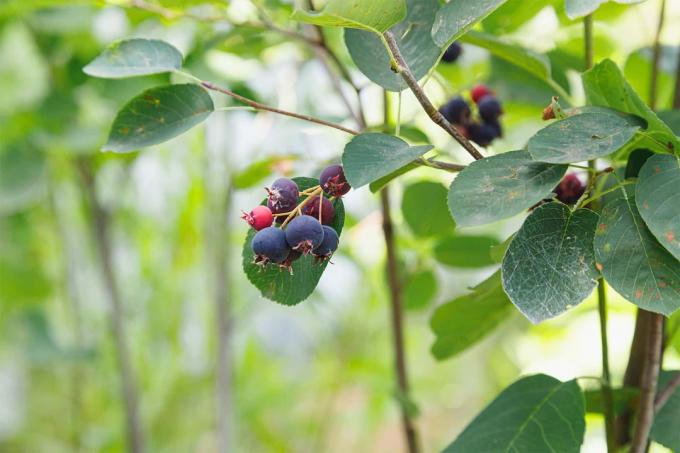
- Happen: Slopes, steep slopes, light forest areas (oaks, pines), semi-arid meadows
- fruit ripening: from the end of June
- growth height: 100 to 400 cm
- Growth: dense, hands branched
Common privet (Ligustrum vulgare)
The privet is considered by many home hedge popular, but you should watch out for the blue to deep black berries. Various alkaloids and glycosides in the fruit can lead to symptoms such as nausea or severe diarrhea after excessive consumption. In addition to the colour, the berries are easily recognizable by their spherical shape.

- Happen: prefers loam or clay soils
- fruit ripening: from September
- growth height: 150 to 450 cm
- Growth: dense, richly branched
K – T
culture plum (Prunus domestica)
Depending on the variety, the cultivated plum produces blue fruits, which are poisonous due to the core they contain. The core contains large amounts of hydrocyanic acid and must be removed before consumption. In addition, dogs and cats should not eat too many plums, as the peel has a strong effect on digestion and can cause stomach problems.

- Happen: prefers sheltered locations
- fruit ripening:July to October
- growth height: 400 to 800 cm
- Growth: erect, opulent crowns
Sadebaum (Juniperus sabina)
Compared to juniper, you have to be careful not to eat the highly poisonous berries of the sallow tree. Even small amounts of sade tree oil can lead to irritation of the gastric mucosa and even death. The berry-shaped cones can be recognized by their blue-black color and the frosting.
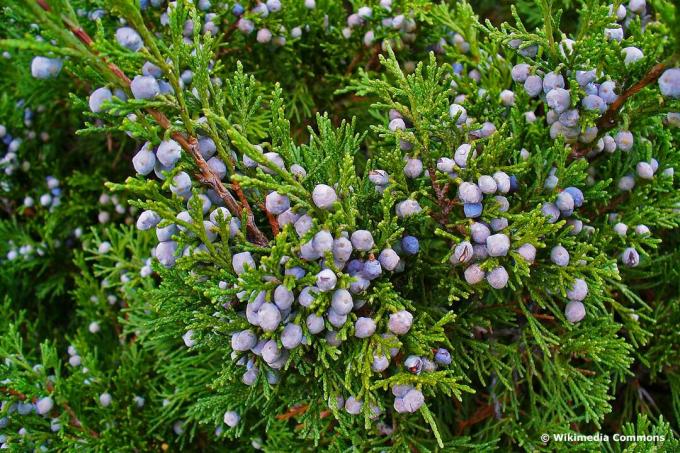
- Happen: mountains
- fruit ripening: September to November
- growth height: 100 to 500 cm
- Growth: dense, creeping to erect
blackthorn (Prunus spinosa)
Like the plum, the sloe is a native plant whose flesh is edible, but the stone is poisonous due to the hydrocyanic acid it contains. In addition, they are only suitable for pets in small quantities.
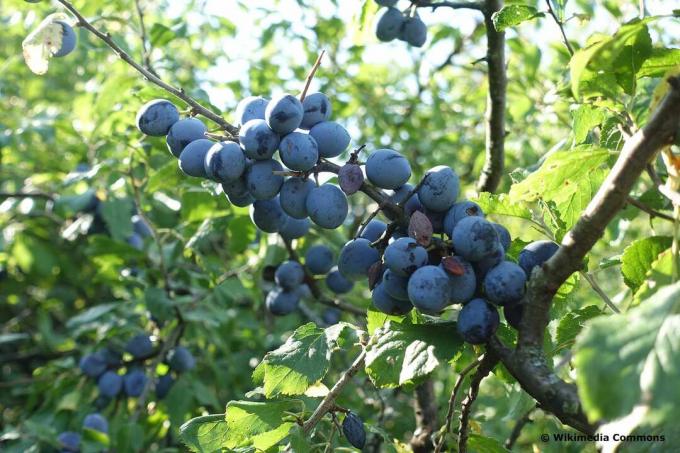
- Happen: forest edges, vineyards
- fruit ripening: November to December
- growth height: up to 300 cm
- Growth: dense, multi-stemmed
Black honeysuckle (Lonicera nigra)
Black fruits with clearly recognizable blue frosting draw attention to this native plant. Due to the alkaloids and bitter substances (xylostone) they contain, they cause symptoms such as nausea, sweating or diarrhea when consumed.
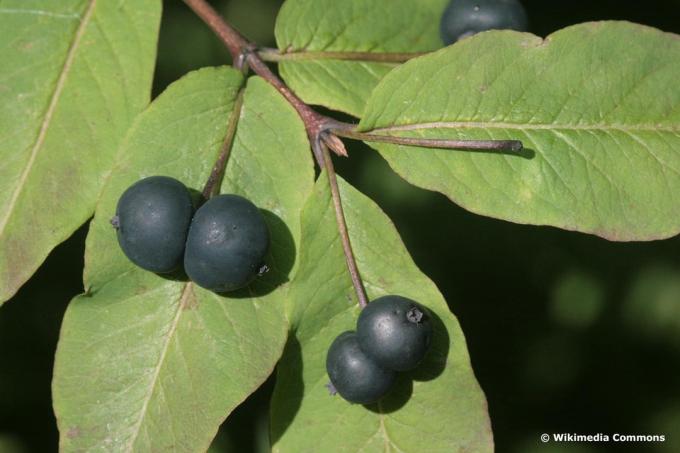
- Happen: mountains
- fruit ripening: July to late August
- growth height: up to 200 cm
- Growth: upright
deadly nightshade (Atropa belladonna)
The deadly nightshade is one of the best-known poisonous plants in German-speaking countries and can be recognized by its blue to deep black berries. Already three berries in children and ten in adults can lead to death. Even birds suffer from the poisonous effect of the forest nightshade.

- Happen: Forest clearings, fallow ground, forest edges
- fruit ripening: August to mid-October
- growth height: 50 to 150 cm
- Growth: herbaceous with storage organ
V – W
Many-flowered claret (Polygonatum multiflorum)
The many-flowered claret is similar to the fragrant claret in growth and toxicity. The berries range from dark blue to jet black in color and cause stomach upset, nausea, and headaches. Because of their shape, children in particular can mistake them for blueberries.

- Happen: Mixed forests (conifers, oaks, beeches)
- fruit ripening: August to mid-September
- growth height: 30 to 100 cm
- Growth: herbaceous, persistent, overhanging
grapevine (Vitis vinifera subsp. vinifera)
The grapevine is not poisonous to humans, but even more so to pets. Dogs in particular suffer severe symptoms due to the tartaric acid it contains, ranging from lethargy to blood in the urine to death from kidney failure. This species is the cultivated subspecies of Vitis vinifera, which can also occur in the wild.

- Happen: Hilly areas, alluvial forests
- fruit ripening: August to mid-November
- growth height: up to 20 m
- Growth:climbing
A notice: Grapevines not only form blue berries, the toxic to pets are. If you discover specimens with white-green grapes, you should keep your four-legged friend away from them.
Woolly snowball (Viburnum lantana)
With the exception of north-west Germany, the woolly snowball is native to the entire German-speaking area. The decorative shrub forms red, egg-shaped fruits, which remain blue to deep black on the plant until winter. Vomiting and nausea are caused by the contained triterpenes.
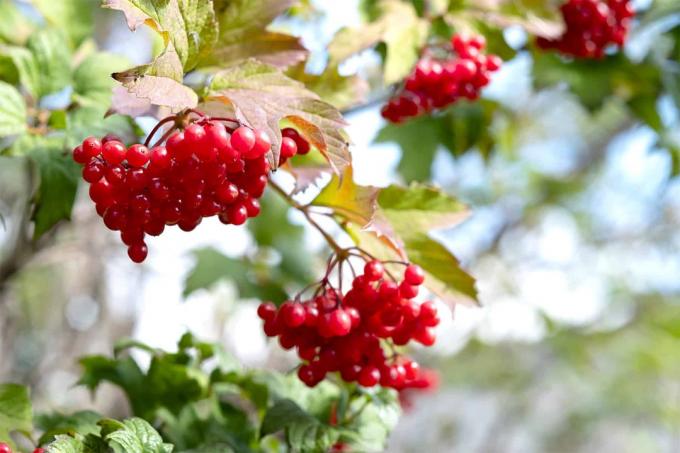
- Happen: Roadsides, clusters of shrubs, pine forests, mixed oak forests
- fruit ripening: from the beginning of September
- growth height: 100 to 400 cm
- Growth: dense, upright
frequently asked Questions
If you cultivate one or more of the plants mentioned, ideally wear gloves during maintenance. In many plants, the toxins are not only found in the blue berries, but in other parts of the plant. This can, for example, lead to contact dermatitis during a grooming cut if the plant sap gets on your skin.
Primarily the self-climbing virgin vine (Parthenocissus quinquefolia), common mahonia (Mahonia aquifolium) and the love pearl bush (Callicarpa bodinieri) should be mentioned here. These neophytes can now be found in the wild and also produce poisonous blue colored berries.
If poisonous blue berries have been eaten, the victim should remain calm and not vomit. Contact the poison control center, doctor, or hospital in your area. If possible, take berries and plant parts with you to identify the plant, which will facilitate first aid measures.



